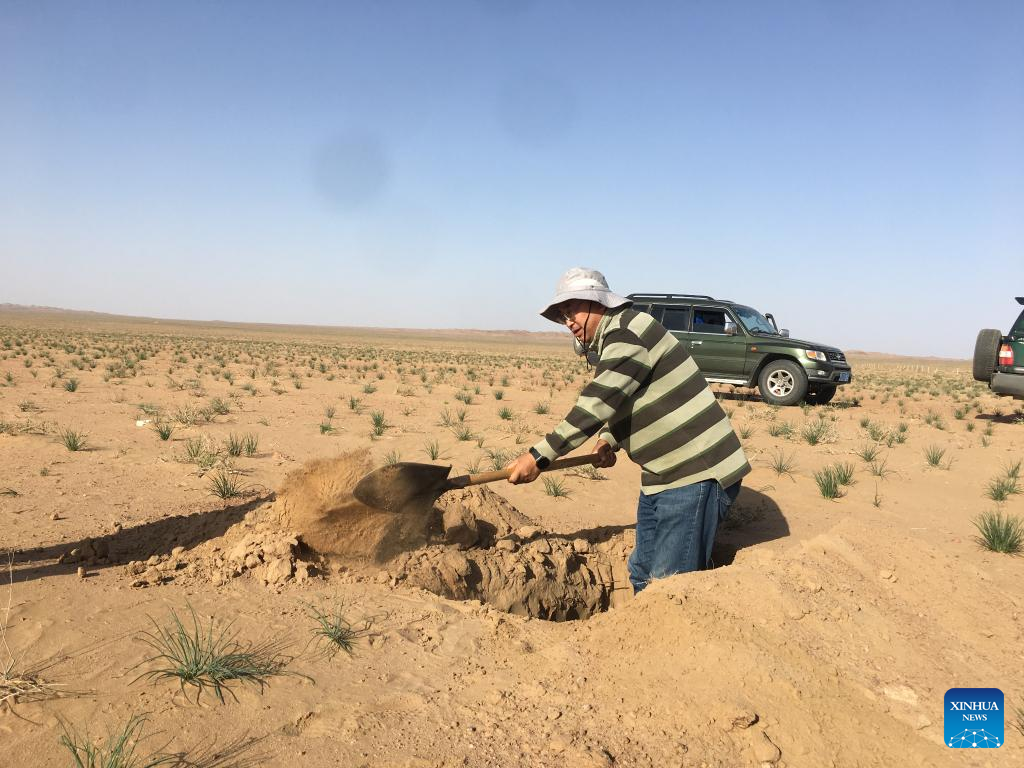
File photo taken on Oct. 11, 2021 shows Ma Quanlin, deputy head of the Gansu Desert Control Research Institute in northwest China's Gansu Province, getting soil sample in Tengger desert. (Xinhua)
LANZHOU, June 29 (Xinhua) -- Whenever a sandstorm strikes, people go out less to avoid the dust. But for Ma Quanlin, the bigger the dust is, the more he has to rush to the source of the sandstorm.
Ma, deputy head of the Gansu Desert Control Research Institute in northwest China's Gansu Province, has been engaged in sand control for more than 20 years. Now, he conducts scientific research mainly in Minqin County, an artificial oasis between Badain Jaran and Tengger, two large deserts in China covering 85,000 square km.
In the past decade, based on the long-term observation and research results of wind-sand flow, Ma's team successfully restored the degraded artificial Haloxylon forest while applying wind-proof and sand-fixing functions in Minqin.
A large-scale Haloxylon afforestation project started in the 1960s in arid desert areas of China, including Minqin, which has brought great environmental benefits to promote ecological restoration and reconstruction in arid regions. However, due to the high afforestation density and the decline of groundwater levels, the artificial Haloxylon forest built on the edge of the oasis was once degraded, and its windbreak and sand fixation functions were reduced.
Ma's team did restoration experiments and studies on different degraded artificial Haloxylon forests.
They found that precise drip irrigation and re-laying sand barriers in Haloxylon forests can massively increase the soil moisture content of the forest land and enhance its photosynthesis process, thus increasing the number of community species and coverage.
After three years of drip irrigation in spring, the degraded forest in Minqin resumed regular growth. The species composition number and coverage of the forest species also increased. It effectively enhanced its wind-proof and sand-fixing ability.
After guarding green barriers on the edge of the desert, the team is exploring a path for locals to increase income.
They chose Agriophyllum quarrosum, known as "sand rice," to conduct the breeding, cultivation, and product research and development of the economic plant in deserts.
They established a 1.3-hectare demonstration base in Minqin in 2021 and successfully screened four excellent sand rice strains. The team developed nine kinds of sand rice products and promoted the deep processing of the products. They also developed the sand rice planter and threshing and cleaning machine, which solved the problems during the planting, harvesting, and cleaning process.
"There's a long way to go for us to protect ecology in desert areas of western China, and we need to make persistent efforts to construct the ecological barriers," said Ma. ■

File photo taken on July 25, 2021 shows the restored forestation on Tengger desert, result of the work of a team led by Ma Quanlin, deputy head of the Gansu Desert Control Research Institute in northwest China's Gansu Province. (Xinhua/Zhang Wenjing)



